Abstract
OBJECTIVES. Breast cancer mortality may be reduced if the disease is detected early through targeted screening programs. Current screening guidelines are based solely on a woman's age. Because working populations are accessible for intervention, occupational identification may be a way of helping to define and locate risk groups and target prevention. METHODS. We used a database consisting of 2.9 million occupationally coded death certificates collected from 23 states between 1979 and 1987 to calculate age-adjusted, race-specific proportionate mortality ratios for breast cancer according to occupation. We performed case-control analyses on occupational groups and on stratifications within the teaching profession. RESULTS. We found a number of significant associations between occupation and frequency of breast cancer. For example, white female professional, managerial, and clerical workers all had high proportions of breast cancer death. High rates of breast cancer in teachers were found in both proportionate mortality ratio and case-control analyses. CONCLUSIONS. These findings may serve as in an aid in the effective targeting of work-site health promotion programs. They suggest that occupationally coded mortality data can be a useful adjunct in the difficult task of identifying groups at risk of preventable disease.
Full text
PDF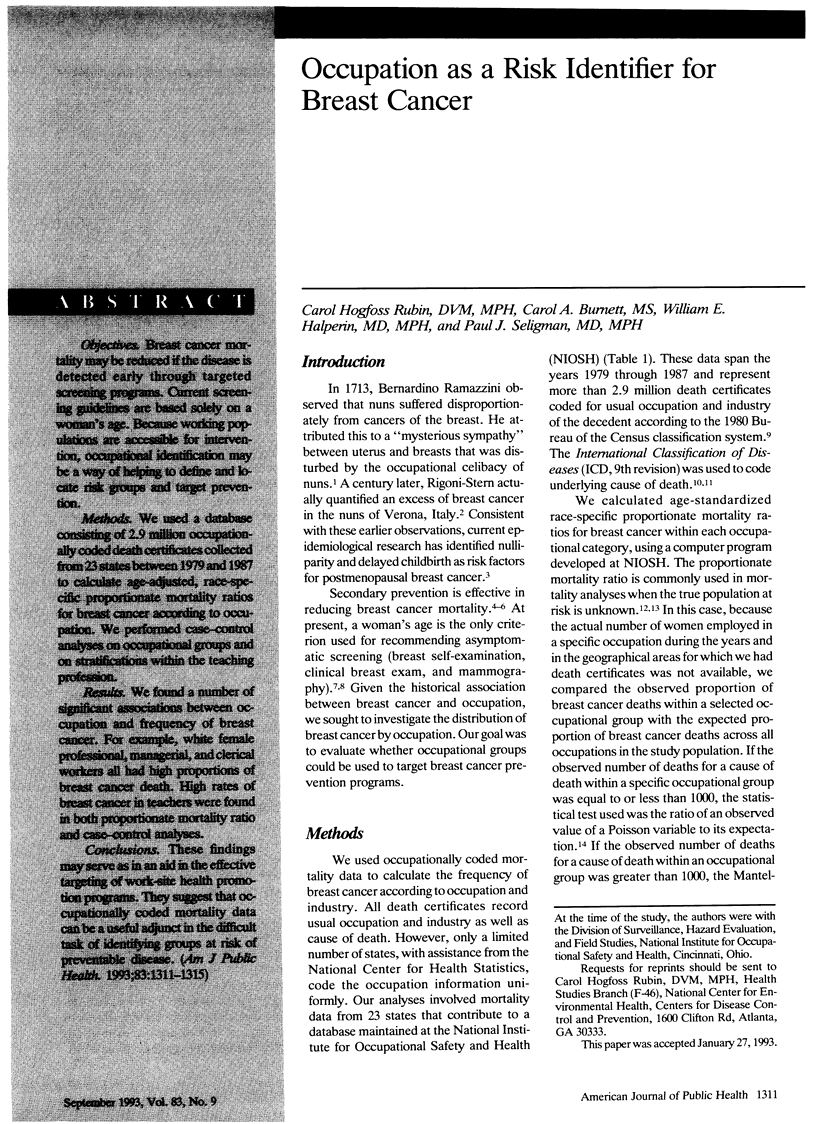
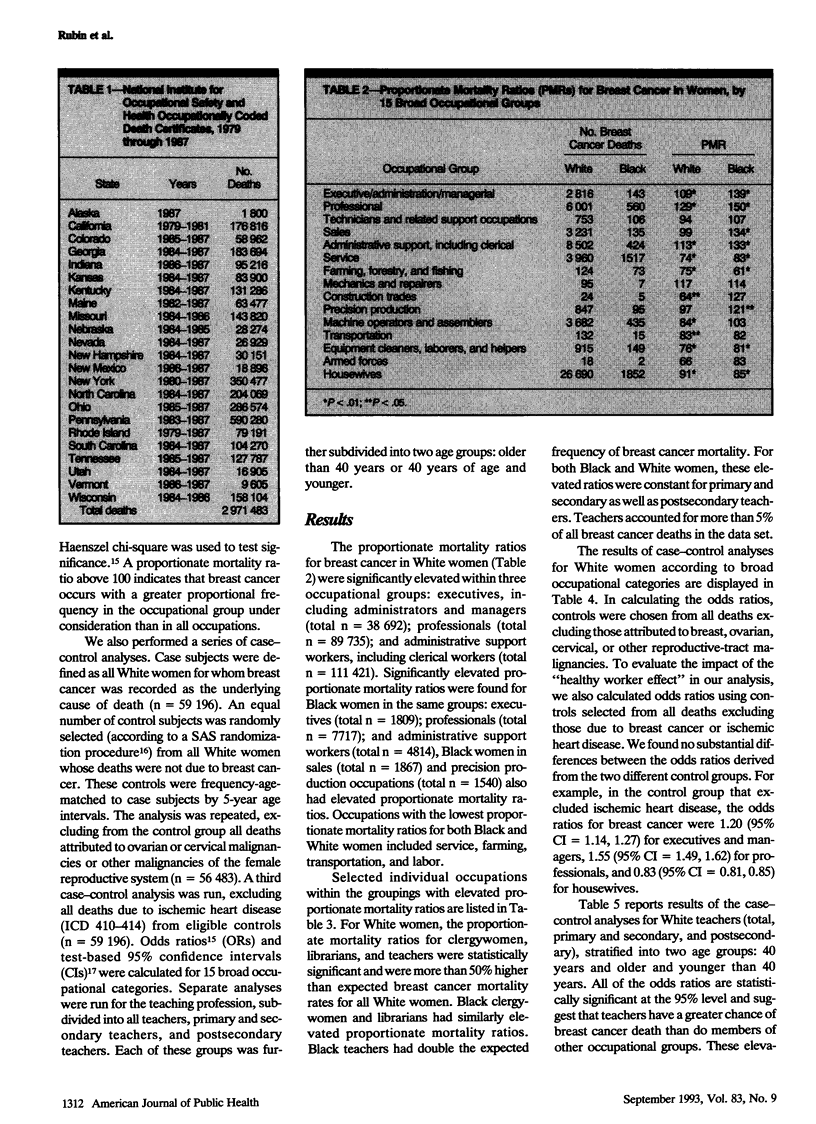
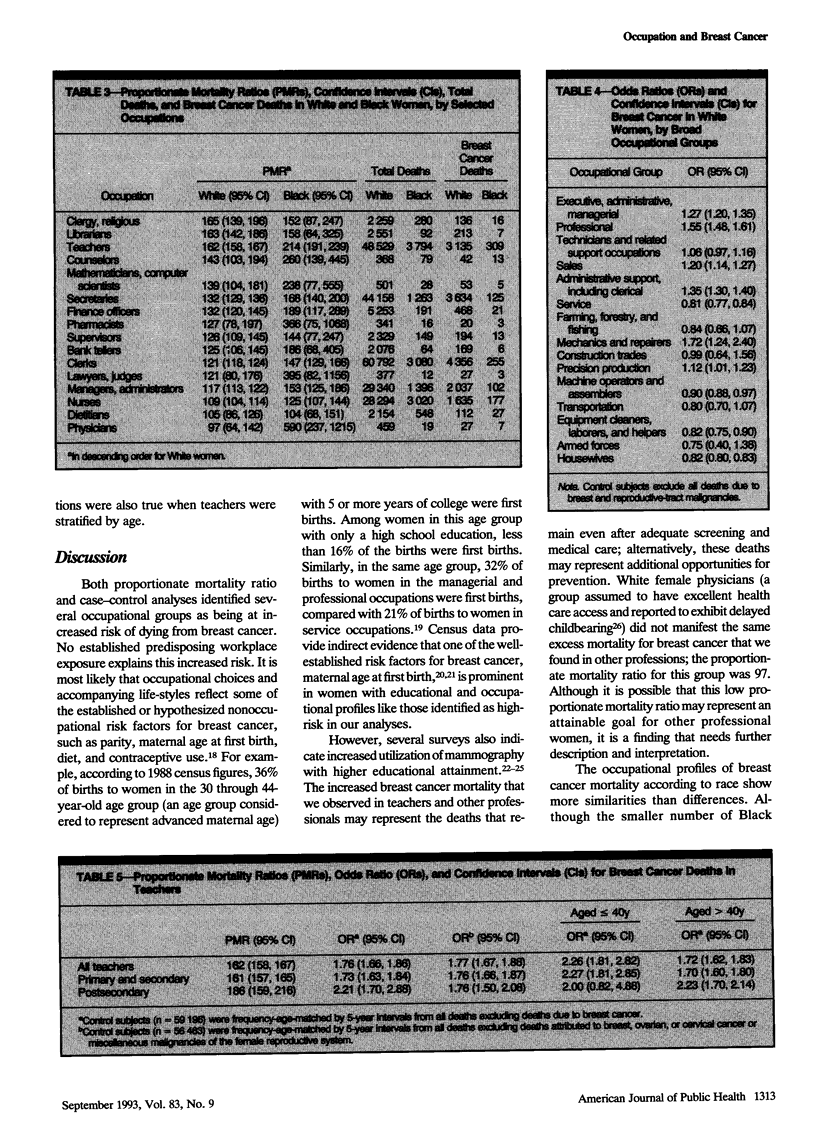
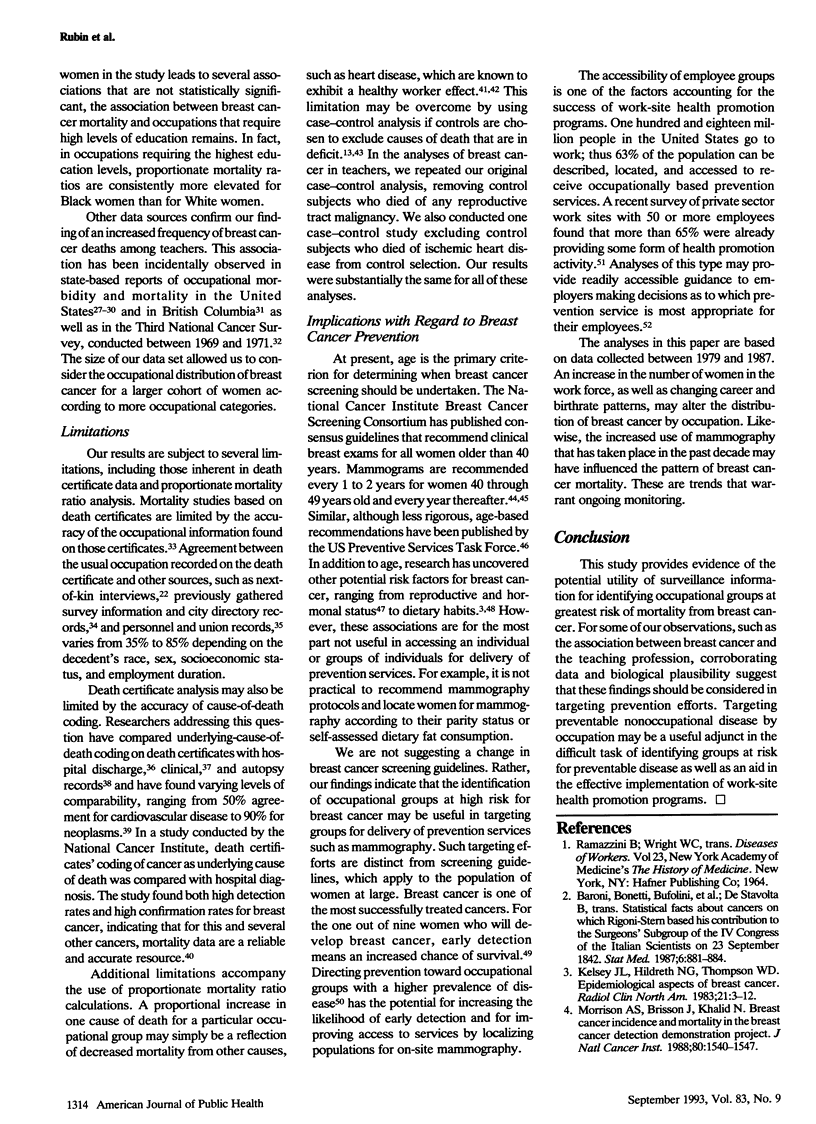
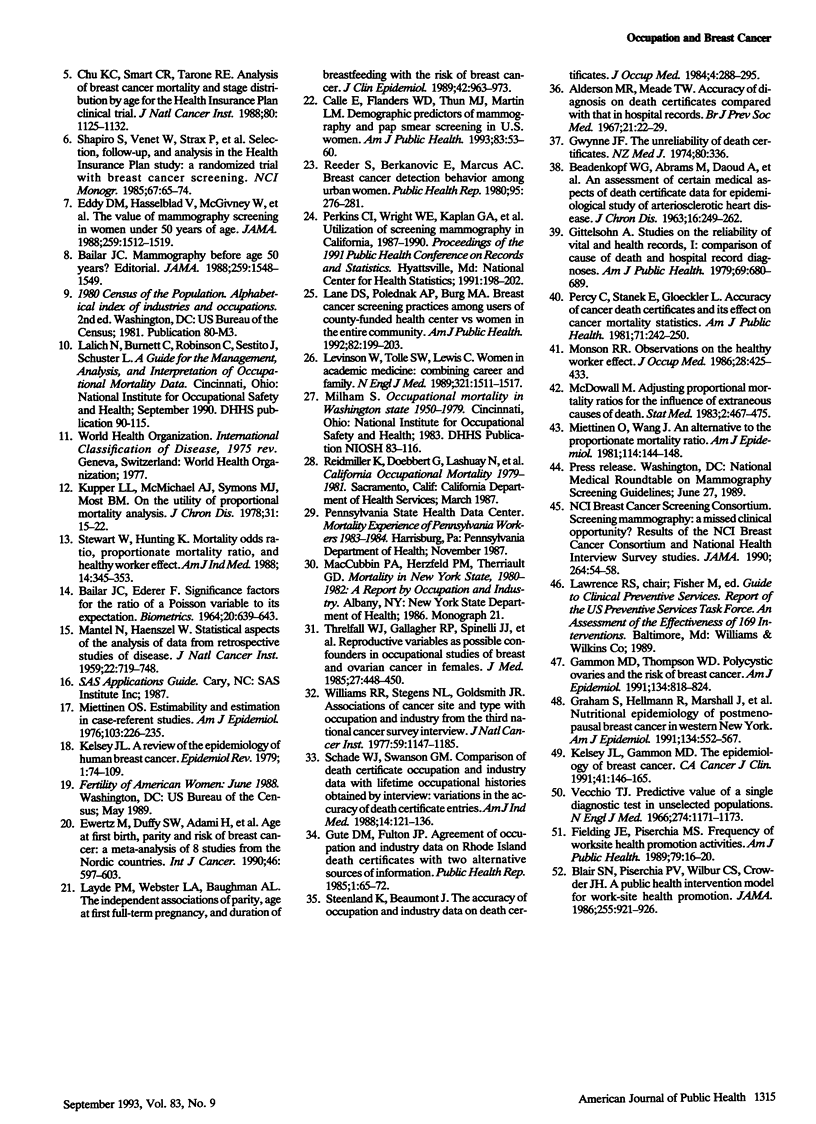
Selected References
These references are in PubMed. This may not be the complete list of references from this article.
- Alderson M. R., Meade T. W. Accuracy of diagnosis on death certificates compared with that in hospital records. Br J Prev Soc Med. 1967 Jan;21(1):22–29. doi: 10.1136/jech.21.1.22. [DOI] [PMC free article] [PubMed] [Google Scholar]
- BEADENKOPF W. G., ABRAMS M., DAOUD A., MARKS R. U. An assessment of certain medical aspects of death certificate data for epidemiologic study of arteriosclerotic heart disease. J Chronic Dis. 1963 Mar;16:249–262. doi: 10.1016/0021-9681(63)90030-4. [DOI] [PubMed] [Google Scholar]
- Bailar J. C., 3rd Mammography before age 50 years? JAMA. 1988 Mar 11;259(10):1548–1549. [PubMed] [Google Scholar]
- Blair S. N., Piserchia P. V., Wilbur C. S., Crowder J. H. A public health intervention model for work-site health promotion. Impact on exercise and physical fitness in a health promotion plan after 24 months. JAMA. 1986 Feb 21;255(7):921–926. [PubMed] [Google Scholar]
- Calle E. E., Flanders W. D., Thun M. J., Martin L. M. Demographic predictors of mammography and Pap smear screening in US women. Am J Public Health. 1993 Jan;83(1):53–60. doi: 10.2105/ajph.83.1.53. [DOI] [PMC free article] [PubMed] [Google Scholar]
- Chu K. C., Smart C. R., Tarone R. E. Analysis of breast cancer mortality and stage distribution by age for the Health Insurance Plan clinical trial. J Natl Cancer Inst. 1988 Sep 21;80(14):1125–1132. doi: 10.1093/jnci/80.14.1125. [DOI] [PubMed] [Google Scholar]
- Eddy D. M., Hasselblad V., McGivney W., Hendee W. The value of mammography screening in women under age 50 years. JAMA. 1988 Mar 11;259(10):1512–1519. [PubMed] [Google Scholar]
- Ewertz M., Duffy S. W., Adami H. O., Kvåle G., Lund E., Meirik O., Mellemgaard A., Soini I., Tulinius H. Age at first birth, parity and risk of breast cancer: a meta-analysis of 8 studies from the Nordic countries. Int J Cancer. 1990 Oct 15;46(4):597–603. doi: 10.1002/ijc.2910460408. [DOI] [PubMed] [Google Scholar]
- Fielding J. E., Piserchia P. V. Frequency of worksite health promotion activities. Am J Public Health. 1989 Jan;79(1):16–20. doi: 10.2105/ajph.79.1.16. [DOI] [PMC free article] [PubMed] [Google Scholar]
- Gammon M. D., Thompson W. D. Polycystic ovaries and the risk of breast cancer. Am J Epidemiol. 1991 Oct 15;134(8):818–824. doi: 10.1093/oxfordjournals.aje.a116156. [DOI] [PubMed] [Google Scholar]
- Gittelsohn A., Senning J. Studies on the reliability of vital and health records: I. Comparison of cause of death and hospital record diagnoses. Am J Public Health. 1979 Jul;69(7):680–689. doi: 10.2105/ajph.69.7.680. [DOI] [PMC free article] [PubMed] [Google Scholar]
- Graham S., Hellmann R., Marshall J., Freudenheim J., Vena J., Swanson M., Zielezny M., Nemoto T., Stubbe N., Raimondo T. Nutritional epidemiology of postmenopausal breast cancer in western New York. Am J Epidemiol. 1991 Sep 15;134(6):552–566. doi: 10.1093/oxfordjournals.aje.a116129. [DOI] [PubMed] [Google Scholar]
- Gute D. M., Fulton J. P. Agreement of occupation and industry data on Rhode Island death certificates with two alternative sources of information. Public Health Rep. 1985 Jan-Feb;100(1):65–72. [PMC free article] [PubMed] [Google Scholar]
- Gwynne J. F. The unreliability of death certificates. N Z Med J. 1974 Oct 23;80(526):336–336. [PubMed] [Google Scholar]
- Kelsey J. L. A review of the epidemiology of human breast cancer. Epidemiol Rev. 1979;1:74–109. doi: 10.1093/oxfordjournals.epirev.a036215. [DOI] [PubMed] [Google Scholar]
- Kelsey J. L., Gammon M. D. The epidemiology of breast cancer. CA Cancer J Clin. 1991 May-Jun;41(3):146–165. doi: 10.3322/canjclin.41.3.146. [DOI] [PubMed] [Google Scholar]
- Kelsey J. L., Hildreth N. G., Thompson W. D. Epidemiologic aspects of breast cancer. Radiol Clin North Am. 1983 Mar;21(1):3–12. [PubMed] [Google Scholar]
- Kupper L. L., McMichael A. J., Symons M. J., Most B. M. On the utility of proportional mortality analysis. J Chronic Dis. 1978 Jan;31(1):15–22. doi: 10.1016/0021-9681(78)90077-2. [DOI] [PubMed] [Google Scholar]
- Lane D. S., Polednak A. P., Burg M. A. Breast cancer screening practices among users of county-funded health centers vs women in the entire community. Am J Public Health. 1992 Feb;82(2):199–203. doi: 10.2105/ajph.82.2.199. [DOI] [PMC free article] [PubMed] [Google Scholar]
- Layde P. M., Webster L. A., Baughman A. L., Wingo P. A., Rubin G. L., Ory H. W. The independent associations of parity, age at first full term pregnancy, and duration of breastfeeding with the risk of breast cancer. Cancer and Steroid Hormone Study Group. J Clin Epidemiol. 1989;42(10):963–973. doi: 10.1016/0895-4356(89)90161-3. [DOI] [PubMed] [Google Scholar]
- Levinson W., Tolle S. W., Lewis C. Women in academic medicine. Combining career and family. N Engl J Med. 1989 Nov 30;321(22):1511–1517. doi: 10.1056/NEJM198911303212205. [DOI] [PubMed] [Google Scholar]
- MANTEL N., HAENSZEL W. Statistical aspects of the analysis of data from retrospective studies of disease. J Natl Cancer Inst. 1959 Apr;22(4):719–748. [PubMed] [Google Scholar]
- McDowall M. Adjusting proportional mortality ratios for the influence of extraneous causes of death. Stat Med. 1983 Oct-Dec;2(4):467–475. doi: 10.1002/sim.4780020405. [DOI] [PubMed] [Google Scholar]
- Miettinen O. S., Wang J. D. An alternative to the proportionate mortality ratio. Am J Epidemiol. 1981 Jul;114(1):144–148. doi: 10.1093/oxfordjournals.aje.a113161. [DOI] [PubMed] [Google Scholar]
- Miettinen O. Estimability and estimation in case-referent studies. Am J Epidemiol. 1976 Feb;103(2):226–235. doi: 10.1093/oxfordjournals.aje.a112220. [DOI] [PubMed] [Google Scholar]
- Monson R. R. Observations on the healthy worker effect. J Occup Med. 1986 Jun;28(6):425–433. doi: 10.1097/00043764-198606000-00009. [DOI] [PubMed] [Google Scholar]
- Morrison A. S., Brisson J., Khalid N. Breast cancer incidence and mortality in the breast cancer detection demonstration project [published errtum appears in J Natl Cancer Inst 1989 Oct 4;81(19):1513]. J Natl Cancer Inst. 1988 Dec 7;80(19):1540–1547. doi: 10.1093/jnci/80.19.1540. [DOI] [PubMed] [Google Scholar]
- Percy C., Stanek E., 3rd, Gloeckler L. Accuracy of cancer death certificates and its effect on cancer mortality statistics. Am J Public Health. 1981 Mar;71(3):242–250. doi: 10.2105/ajph.71.3.242. [DOI] [PMC free article] [PubMed] [Google Scholar]
- Reeder S., Berkanovic E., Marcus A. C. Breast cancer detection behavior among urban women. Public Health Rep. 1980 May-Jun;95(3):276–281. [PMC free article] [PubMed] [Google Scholar]
- Schade W. J., Swanson G. M. Comparison of death certificate occupation and industry data with lifetime occupational histories obtained by interview: variations in the accuracy of death certificate entries. Am J Ind Med. 1988;14(2):121–136. doi: 10.1002/ajim.4700140203. [DOI] [PubMed] [Google Scholar]
- Shapiro S., Venet W., Strax P., Venet L., Roeser R. Selection, follow-up, and analysis in the Health Insurance Plan Study: a randomized trial with breast cancer screening. Natl Cancer Inst Monogr. 1985 May;67:65–74. [PubMed] [Google Scholar]
- Steenland K., Beaumont J. The accuracy of occupation and industry data on death certificates. J Occup Med. 1984 Apr;26(4):288–296. [PubMed] [Google Scholar]
- Stewart W., Hunting K. Mortality odds ratio, proportionate mortality ratio, and healthy worker effect. Am J Ind Med. 1988;14(3):345–353. doi: 10.1002/ajim.4700140312. [DOI] [PubMed] [Google Scholar]
- Threlfall W. J., Gallagher R. P., Spinelli J. J., Band P. R. Reproductive variables as possible confounders in occupational studies of breast and ovarian cancer in females. J Occup Med. 1985 Jun;27(6):448–450. [PubMed] [Google Scholar]
- Vecchio T. J. Predictive value of a single diagnostic test in unselected populations. N Engl J Med. 1966 May 26;274(21):1171–1173. doi: 10.1056/NEJM196605262742104. [DOI] [PubMed] [Google Scholar]
- Williams R. R., Stegens N. L., Goldsmith J. R. Associations of cancer site and type with occupation and industry from the Third National Cancer Survey Interview. J Natl Cancer Inst. 1977 Oct;59(4):1147–1185. doi: 10.1093/jnci/59.4.1147. [DOI] [PubMed] [Google Scholar]


